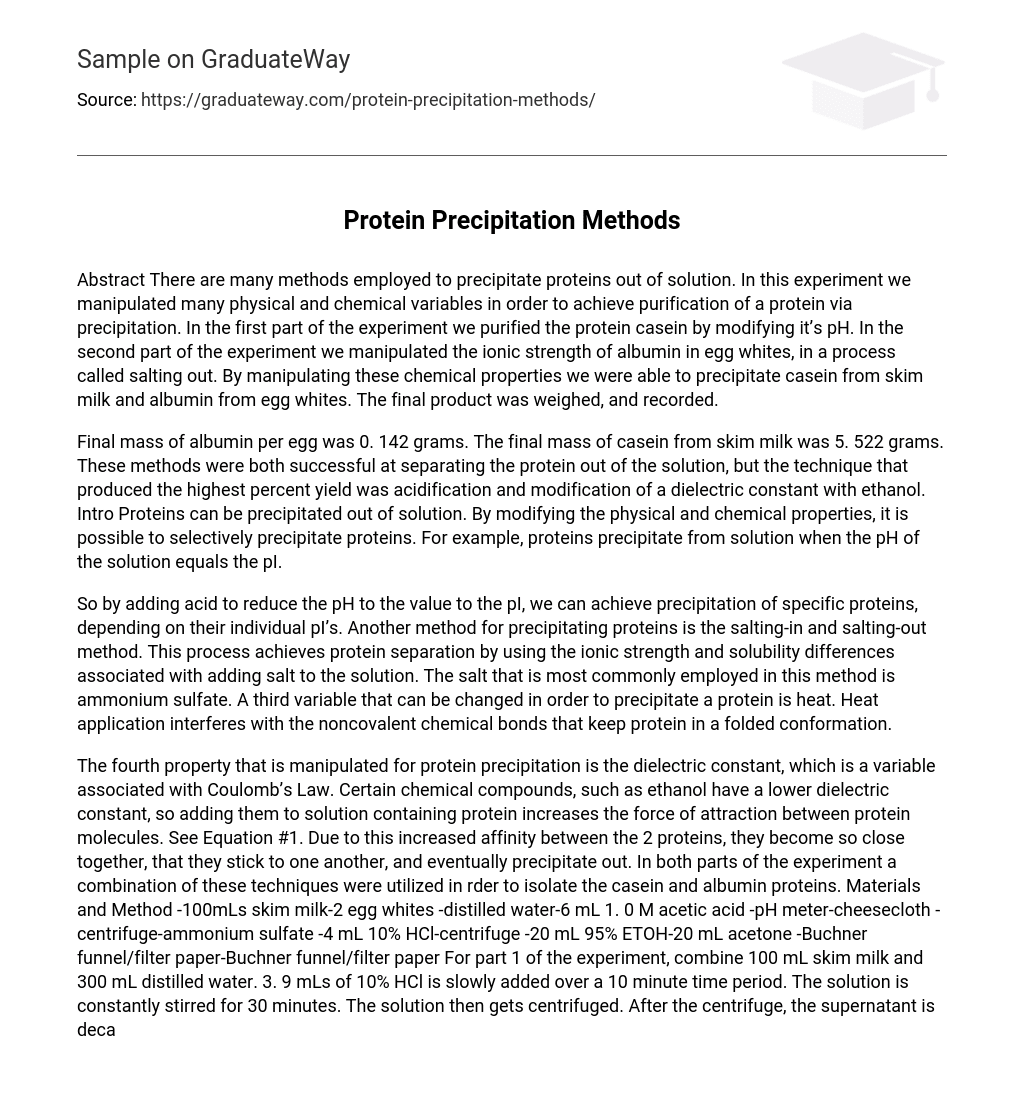Abstract: Various techniques are used to precipitate proteins from solution. In this experiment, we altered several physical and chemical factors to purify a protein through precipitation. Initially, we adjusted the pH of casein to purify it. Subsequently, we manipulated the ionic strength of albumin in egg whites using a process called salting out. By controlling these chemical properties, we successfully precipitated casein from skim milk and albumin from egg whites. The weight of the final product was measured and recorded.
The albumin in each egg had a final mass of 0.142 grams, while the casein from skim milk had a final mass of 5.522 grams. Both methods successfully separated the protein from the solution. However, the technique that yielded the highest percentage was acidification and modification of the dielectric constant using ethanol. Introduction: Proteins can be precipitated from a solution by altering their physical and chemical properties. Selective protein precipitation can be achieved by adjusting the pH of the solution to match the isoelectric point (pI) at which proteins precipitate.
By adjusting the pH with acid to match the protein’s pI, we can cause specific proteins to precipitate. Another approach to protein precipitation is the salting-in/ salting-out method, which takes advantage of the ionic strength and solubility changes induced by adding salt to the solution. Ammonium sulfate is typically used for this purpose. Additionally, heat can be used to precipitate proteins by disrupting the noncovalent bonds responsible for their folded conformation.
The dielectric constant, a property associated with Coulomb’s Law, is the fourth manipulated variable for protein precipitation. Certain chemical compounds, like ethanol, have a lower dielectric constant. Consequently, when these compounds are added to a protein solution, the force of attraction between protein molecules (Equation #1) increases. This heightened affinity causes the proteins to come closer together and eventually precipitate. Both parts of the experiment involved using various techniques to isolate casein and albumin proteins. The materials utilized in the experiment included 100mL skim milk, 2 egg whites, distilled water, 6 mL 1.0 M acetic acid, a pH meter, cheesecloth, a centrifuge, ammonium sulfate, 4 mL 10% HCl, 20 mL 95% ETOH (ethanol), 20 mL acetone, Buchner funnel and filter paper. In part 1 of the experiment: Skim milk and distilled water are combined at ratios of 100 mL and 300 mL respectively. Subsequently over a span of ten minutes while continuously stirring for thirty minutes,the solution is slowly stirred with an addition of3 .9 mls of10 % HCl . Afterward ,the supernatant is decanted after centrifuging it.Finally , Ethanol equivalent to about twenty milliliters is mixed.
The solution is filtered using a Buchner funnel, collected, and weighed. In the second part of the experiment, 2 egg whites are combined with 5.6 mLs of acetic acid. This mixture then goes through a double-layered cheesecloth. Ammonium sulfate (25mLs) is added and the solution is stirred for 30 minutes. After centrifuging, the supernatant is collected while discarding the precipitate. Additional 1 mL of ammonium sulfate is added while stirring until the solution becomes turbid. The decanted supernatant undergoes another round of centrifugation.
After performing the final centrifugation, 20 mLs of acetone was included, and the compound was filtered under vacuum, collected, and measured. Results and Discussion- In the initial part of the experiment, acid was utilized to decrease the pH of skim milk. When the pH equals the pI value, protein will precipitate. The pH of milk is approximately 6.5. The casein pI is 4.6. By adding acid to the milk and reducing the pH from 6.5 to 4.6, we effectively induced the separation of the protein. (See Equation #2) If skim milk contained another protein with a pI of 3.5, additional acid would be required to induce precipitation alongside the casein protein.
At the isoelectric point, a protein has no charge and low solubility in water. It becomes positively charged at low pH and negatively charged at high pH. To selectively precipitate a protein with an isoelectric point of 3.5, adjust the solution’s pH to 3.5, allowing for selective precipitation when multiple proteins are present.
The recovered mass of casein from skim milk was 5.522 grams, resulting in a reasonable percent yield of 69.025% (calculation #1).
Milk contains three main types of protein: casein, lactalbumins, and lactoglobulins.
Ethanol and acetone are commonly used to precipitate proteins by exploiting attractive forces between them based on Coulomb’s Law and the charges of the proteins involved. The force depends on their distance apart as well as the dielectric constant.
Reducing the dielectric constant increases the force of attraction between proteins, causing them to precipitate out of solution when they strongly adhere together.
The recovered mass of albumin per egg was 0.142 grams with a remarkably low percent yield of 2% (calculation #2). This may be due to using only egg whites without incorporating yolks where significant albumin concentration likely exists. Additionally, the effectiveness of the precipitation method used may be less than that of other methods.
Various methods are employed to precipitate proteins from a solution, utilizing the distinct chemical and physical characteristics of each protein. One approach involves modifying the pH to correspond with the isoelectric point. In the initial stage, acid was introduced to decrease the pH, while ethanol was utilized to manipulate the dielectric constant. In the subsequent phase, both pH reduction and a secondary technique known as “salting out” were implemented. Ammonium sulfate was used in this technique to precipitate the protein.
The highest increase in protein production was observed in acidification and dielectric constant, as determined by percent yield calculations. It is important to consider that this result may be influenced by the experimental design, since we did not include the protein in egg yolks when calculating. Moreover, the low percent yield obtained from precipitating casein from skim milk could be attributed to lactalbumins and lactoglobulins being included with the total protein, which might not have precipitated along with the casein.





